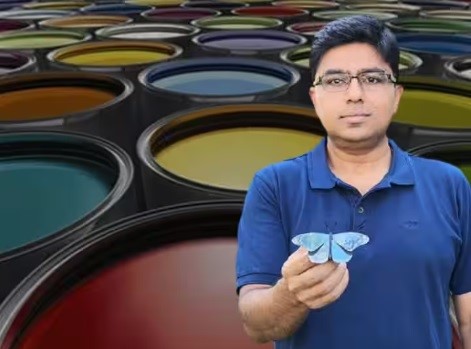

Professor Debashis Chanda, with his team of extraordinary gentlemen at the UCF NanoScience Technology Center, has discovered a plasmonic paint that is extremely lightweight. The paint uses the nanoscale structural arrangement of colourless materials, such as aluminium and aluminium oxides and is an amazing energy-saving alternative to the conventional paints used.

Chanda claims that this new lightweight paint is not composed of similar synthetic compounds found in actual pigment-based colourants; rather, it uses colourless and odourless materials such as aluminium and aluminium oxide to formulate an energy-saving option for industrial application. The plasmonic paint does not trap heat, thus elongating the product's life cycle.
Chanda went on to clarify that the structural bond of aluminium or aluminium oxide, when exposed to light, emits a structural hue of its own. The scientist illustrated that the research team initially planned to create a continuously stretched aluminium mirror for device publication and processing. During the trial and error phase, he explained how the team began to discover small lumps of aluminium particles, commonly known as nanoislands forming on the mirror's surface. Gradually they realised that by monitoring the size of the nanoislands, there was a probability of creating vivid types of colours.
Chanda mentioned how structural colour is easily visible on a butterfly's wings, a peacock's feathers, or a fish's scales.
"Many butterflies, not all but many butterflies, peacocks, a lot of birds, even some fish, octopus, they have a structure on their skin or on their feathers," Chanda said. "That structure actually inherently has no colour. That means if you crush them, say, some of the butterfly wings, the colour disappears because the constituent material has no colour," he pointed out.
The scientist also shared that there is an absence of authentic pigment on the planet as a change in spacing or how the molecules act guides the geometric alignment of an object creating a specific hue when it comes in contact with light.
Chanda exclaimed: "With pigment for a red colour to go to a blue colour, we need two different molecules, completely different molecules. But for a butterfly to go from red to blue, it just changes the spacing between the material and the geometrical alignment. It does not need two different materials."

Chanda seemed confident about the discovery since the use of aluminium or aluminium oxide negates the toxicity of traditional pigments. Unlike conventional paints that use new molecules to produce each colour, the plasmonic paint can be conditioned to react with available light. Moreover, this lightweight paint can be used in minimal quantities to complete a large job.
"They're extremely thin flakes, hundreds of a nanometer-thin, so they are extremely lightweight compared to any typical metal, metallic particle or organic pigment-based paint," Chanda narrated.
Chanda also claimed that an additional advantage of the paint is it can keep the object's body cooler.
"If we paint something with our structural colour paint versus the pigment-based paint, we show we could demonstrate that it is a 20 to 30 degrees Fahrenheit temperature difference, which is significant," Chanda justified.
Dr Pablo Manuel Cencillo Abad is a postdoctoral researcher from the NanoScience Technology Center working alongside Chanda. The duo is now invested in the thought of producing large commercially viable batches of this plasmonic paint.
Abad clarified that similar research had failed before this because large-scale production seemed impossible.
"One of the reasons why we are using aluminium, to begin with, is because it's pretty common. It's very, very cheap," Abad said.
Abad became a UCF researcher so that he could transverse boundaries to discover new applications of science beneficial to the practical world. He seems incredibly excited about this discovery and addresses his gratitude for participating in the ordeal.
Abad claimed that the use of aluminium had reduced the cost of R&D, which in turn would propel mass production.
"It's not just science for the sake of doing something, but doing something for the sake of having an impact in society, in the real world," Abad concluded.



Responses






